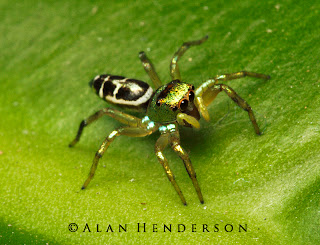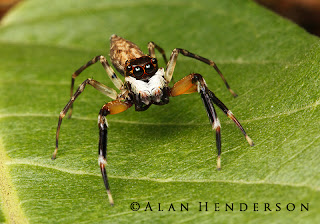 |
Sunday, October 31, 2010
Forest jumpers
The northern tropics are home to a diverse array of jumping spiders (Salticidae). These relatively small spiders are diurnal and are extremely active hunters. They visually locate their prey using their eight eyes which are spread around their heads. The two large anterior eyes provide the spiders with particularly good vision and allow them to judge distances accurately. Most species will stalk prey to within their preferred strike range then leap on it with a great burst of energy. Some species can leap up to 30 times thier body length. Many species will attack prey up to, and sometimes beyond their own body size. Here are a handful of species we have encountered so far.
Thursday, October 21, 2010
Now you see me...
After assisting our neighbour at BatReach with an unwelcome visitor (a 3m Amethystine Python) I was walking back home and spotted an unfamiliar katydid perched on top of a leaf. As soon as I inspected more closely the katydid flattened out in umbrella style, concealing all its typical insect features. The katydid in question appears to belong to be Acauloplacella sp. but I'm waiting on confirmation from katydid guru David Rentz. These katydids have superb camouflage, the wings resembling the leaves they reside in with almost exact venation.
 |
| The katydid in its active posture. |
 |
| Hidden beneath its wings. |
Saturday, October 9, 2010
Gecko crossing
I found this gecko in the middle of a small road through the rainforest while returning from a recent bug trip north west of Kuranda. It's a Chameleon gecko (Carphodactylus laevis), a very large and unusual species, and sole member of its genus. It is nocturnal like most geckos, and forages through the leaf litter for prey. It has a remarkable defensive strategy. Initially the tail is waved if the gecko is threatened by a predator, but under severe duress the gecko will drop its tail. The tail not only continues to wriggle and writhe to distract the predator, it actually makes a noise. An area on the broken section of the tail opens and closes with each movement, and the sound resembles the distress call of a young rodent. Meanwhile the gecko makes its getaway, and can regenerate a new tail within six months.
 |
| The Chameleon gecko (Carphodactylus laevis), after I released it away from the road. |
Tuesday, October 5, 2010
Cape Cassowary
On Sunday we travelled up to Cape Tribulation, about a 2 hour trip from home. We dropped in to the Cape Trib Farmstay to say hi to the people who we've stayed with while on the Melbourne Museum field trips each year. It was extremely wet there - they've only had half a dozen days when it hasn't rained this year. Not good for their fruit.
Late in the day we talk a walk on the boardwalk and spotted a handful of bugs including a 'squirt' of Peppermint stick insects.
The highlight of the day though was an encounter with a wild Cassowary and his very large chick. We came across them while on the boardwalk, and had the chick on one side of us and the male on the other. This made us a little nervous at first, but we remained very still and he did not seem perturbed at all. At one point he joined us on the boardwalk only metres from where we stood transfixed.
Late in the day we talk a walk on the boardwalk and spotted a handful of bugs including a 'squirt' of Peppermint stick insects.
The highlight of the day though was an encounter with a wild Cassowary and his very large chick. We came across them while on the boardwalk, and had the chick on one side of us and the male on the other. This made us a little nervous at first, but we remained very still and he did not seem perturbed at all. At one point he joined us on the boardwalk only metres from where we stood transfixed.
Monday, October 4, 2010
Venturing west
On Wednesday night we took a little trip west to see what was out and about. You don't have to go far to see dramatic changes in the landscape and habitats. One moment you are driving through rainforest, the next you are in open woodland dominated by eucalypts and acacias. Light sheets were set-up by David and Buck who were in search of moths in particular, while I spent most of the evening direct searching for invertebrates and other wildlife on the ground and within the foliage and tree trunks. I wasn't disappointed.
The find of the night for me was yet another spectacular huntsman spider. Not quite as colourful as the Tiger Huntsman we found in 2006, but incredibly, even larger. The seven-legged adult female easily spanned my hand, and like most huntsmen she moved like lightning. I've identified her as Beregama aurea, one of four species in the genus. Two are found in Papua New Guinea, and two within Australia. The other Australian species is Beregama cordata which we have been keeping and breeding for several years. They are rainforest species and we have found them near Cairns, Kuranda and Cape Tribulation.
We have set-up this new specimen in a large terrarium and have been feeding her a steady supply of moths and cockroaches. She has an insatiable appetite so we are hoping she has been mated and will produce eggs.
 |
| A Lycosid (Wolf spider) looking out from her burrow. |
 |
| Juvenile Ornate Burrowing Frog, Opisthodon ornatus. |
 |
| An unusual orb-weaving spider, another species I have encountered for the first time. |
The find of the night for me was yet another spectacular huntsman spider. Not quite as colourful as the Tiger Huntsman we found in 2006, but incredibly, even larger. The seven-legged adult female easily spanned my hand, and like most huntsmen she moved like lightning. I've identified her as Beregama aurea, one of four species in the genus. Two are found in Papua New Guinea, and two within Australia. The other Australian species is Beregama cordata which we have been keeping and breeding for several years. They are rainforest species and we have found them near Cairns, Kuranda and Cape Tribulation.
We have set-up this new specimen in a large terrarium and have been feeding her a steady supply of moths and cockroaches. She has an insatiable appetite so we are hoping she has been mated and will produce eggs.
 |
| The seven- legged 'Golden Huntsman', Beregama aurea |
 |
| What lovely eyes she has! She is a relatively old specimen, evidenced by her buffed and hairless cephalothorax. |
Friday, October 1, 2010
Destination Melbourne Museum
The Green Ant display in Bugs Alive! at Melbourne Museum has been desperately in need of a new colony for the last couple of months. We collected the last colony in December 2009 while on a field trip in north Queensland. That colony survived well for several months but then produced vast numbers of reproductives (new queens and males). This is usually a sign that a captive colony is reaching the end of its life - and that turned out to be the case. Despite our attempts to encourage the new queens to mate with the winged males, none were forthcoming and only infertile eggs were laid.
We have just harvested a new colony for Melbourne Museum's display from our backyard. Four individual silk-bound nests were collected from a passion vine and sent via Express Post. The ants are now happily constructing new nests within their very public home in Bugs Alive!
Green ants are fascinating in many ways. One unusual aspect of their behaviour is the use of their larvae as tools - the larvae produce silk. The worker ants hold the larvae in their mandibles and use their silk producing siblings to bond leaves together to form nests. This occurs whilst other patient ants hold the leaves in place. This laborious process can take several hours.
We have just harvested a new colony for Melbourne Museum's display from our backyard. Four individual silk-bound nests were collected from a passion vine and sent via Express Post. The ants are now happily constructing new nests within their very public home in Bugs Alive!
 |
| One of the Green ant nests that made the journey |
 |
| The ants on full alert - what is that strange man doing with a pair of secateurs and a bucket. |
Green ants are fascinating in many ways. One unusual aspect of their behaviour is the use of their larvae as tools - the larvae produce silk. The worker ants hold the larvae in their mandibles and use their silk producing siblings to bond leaves together to form nests. This occurs whilst other patient ants hold the leaves in place. This laborious process can take several hours.
Subscribe to:
Posts (Atom)








